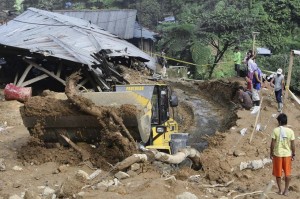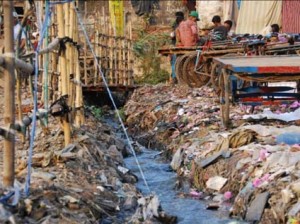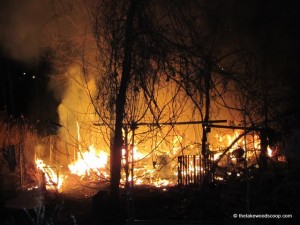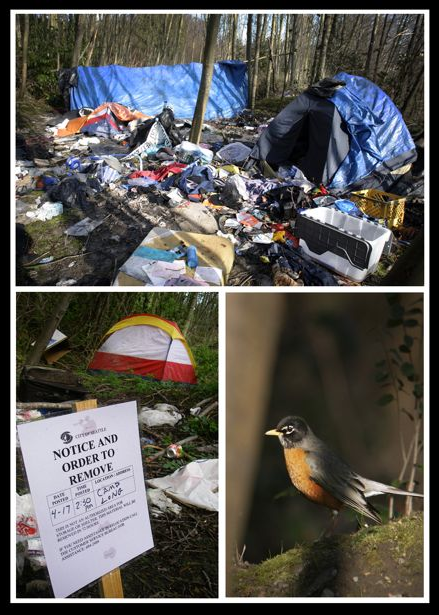It was while I was watching Karl Pilkington on “Idiot Abroad-The Bucket List”, that I began thinking about shanty towns and their environmental impact. Karl in his idiot savant-ish way stated what should have been the obvious to all of us.
“There’s not really much that you can change, is there? You can come down here, build a new hut, donate some money but in the end, you haven’t changed anything have you?”
He was right. This problem of displaced humans is bigger than a Unicef jar or a new hut or a batch of collected clothing. It impacts people, we see that and we have known that for a long time. But it’s also impacting our environment.
Urban poverty poses a great health and environmental risk for everyone, not just those forced to live in it. Because people are marginalized they are forced to live in areas where nobody else will live and they do not face the possibility of being forced out due to development. Poverty puts pressure on people to engage in unsustainable and ecologically damaging practices.
In most areas of the world this means less than desirable land. A swampland or flood zone where maladies like malaria is rampant is the setting for a lot of these shanty towns. The South African ghetto of Soweto was actually built next to a sewage facility so that the poor could be close to work.
In Brazilian cities such as Rio de Janeiro, Belo Horizonte and Recife, the topography has caused much of the urban poor to occupy the hills. Following deforestation, extreme soil compaction and the absence of retaining walls, these dwellings are subject to landslides and dangerous rock falls.
But also to be taken into account is the fact that these towns are extremely DIY. They aren’t built with good materials and no thought is given to sewage, water cleanliness or anything further than a roof really.
A good number of favelas (Brazilian term for shanty town) are also vulnerable to flooding. In Recife, the drainage systems date to colonial times and are clogged with refuse much of the time. There is thus the problem of sewer overflow that causes flooding of entire districts during the rainy season. In Manila, the same problems, accentuated by deforestation, provoke extreme flooding each year that affects the poorest quarter of the population. Extreme flooding in 1998 left 300 000 homeless. Earthquakes were responsible for the destruction of more than 100 million homes during the twentieth century. Of these, the precariously situated shanty towns were among the most affected. One example is the 1976 Guatemala earthquake, where 1.2 million people lost their homes and virtually all of the 59 million households destroyed in the capital were situated in shanty towns.
Very often industries that are already environmentally unsound and full of industrial pollutants like refineries, pesticide factories, electronic waste ‘recycling’, battery recycling, foundries, dry cleaners, tanneries, etc. are situated on the outsides of towns. They uncoincidentally are staffed by people who have little choice in their work because to not work is to not get by. So here again, the shanty towns are situated close to if not within some of the most toxic areas where environmental safeguards are often non-existent.
LANDSLIDE
 Every year Landslides bring death and destruction to the inhabitants of shanty towns from Haiti to Cairo. Undoubtedly, generational deforestation and other natural disasters such as volcanic activity have contributed to this. But these encampments for humanities lost and unwanted also add to the problem.
Every year Landslides bring death and destruction to the inhabitants of shanty towns from Haiti to Cairo. Undoubtedly, generational deforestation and other natural disasters such as volcanic activity have contributed to this. But these encampments for humanities lost and unwanted also add to the problem.
According to a study from 1990, 16% of shanty town dwellers living on the sides of hills in Rio run short- and medium-term risks to their lives and their property (Taschner, 1995). In Caracas, nearly two-thirds of the urban population live on the side of unstable hills where landslides are a permanent danger, a risk intensified by seismic activity in the area (Jiménez Diaz, 1994).
The very fact that the ramshackle townships exist keeps vegetation from re-growing. The degradation of the soil and land by continued contaminant use most likely ensures that nothing will ever grow there again. What we are looking at with this spread of the human unfortunate is the beginnings of desert wastelands. Places that will never again be suitable for habitation and will remain unproductive for centuries.
When this occurs, it is all very well and good to teach the parable of “teaching a man to fish”. But you can teach someone to plant and grow and they will still be unproductive because they have neither enriched soil nor potable water available.
HEALTH ISSUES
According to health surveys of the urban homeless in Toronto:
- New and old diseases are coming back: tuberculosis, HIV/AIDS, lice, scabies, bedbug infestations, Norwalk virus outbreaks, malnutrition.
- The longer a person is on the street the more their health breaks down. Early death of the homeless is very common
(Source: http://votetoronto.ca/~votetoro/en/6/7/166/Homelessness–Social-and-Environmental-Issues.htm)
There are many reasons why homeless people congregating in encampments experience poorer health even than those who visit shelters. They live in close quarters with poor air quality, oftimes due to their heating and cooking fuels. Because their encampments are away and on the outskirts for the most part, they are further from health facilities for the poor. Their diets are poor as is their hygiene by necessity. They also lack survival skills living in urban areas or are unable to employ them due to lack of resources.
The urban poor of shanty towns face both similar and different obstacles to health. HIV/AIDS is extremely prevalent in African Ghettos like Lagos, Nigeria and Soweto, South Africa. This is due to local taboos and practices as well as an inability for aid workers to get to ill people to serve them. People with compromised immune systems also face myriad other disease due to open sewage and close quarters which speeds the progress of HIV. The orphanages around these areas abound with children whose parents have been lost to this disease before their 30’s and very often the children are infected as well.
In other parts of the world, notably South American countries, the urban poor deal with malnutrition due both to unavailability of food and their bodies not being used to non-indigenous foodstuff. This has been a particular problem in Peru.
CLIMATE CHANGE
Climate change is becoming at this stage of the game a case of Chicken and Egg. As noted before in reference to landslides, natural disasters attributable to changes in weather patterns such as those seen of late in Haiti, The Pacific Islands and even, one could argue in Louisiana/Mississippi; these disasters leave people homeless and helpless as to their relocation.
According to the International Organization for Migration, 20 million people were made homeless last year as a result of sudden-onset environmental disasters. But that could rise to one billion in the next 40 years as the effects of climate change take hold, testing not only public attitudes but our capacity to provide support and accommodation.
The Pacific island nations, so vocal at Copenhagen, are already experiencing the effects of climate change. Tuvalu experienced a 7 centimeter rise in sea levels in the 13 years leading up to 2005. If this doesn’t sound significant, bear in mind that the highest point of the low lying coral atolls – home to 10,000 people – is just 3.7 meters above high tide. “We live in constant fear of the adverse impacts of climate change,” Prime Minister Saufatu Sopoanga appeals. “The threat is real and serious, and is of no difference to a slow and insidious form of terrorism against us.”
However, once again the relocation is ultimately to areas unprepared for a huge human influx. Or, it inhibits the natural re-growth that would have occurred if so many people weren’t camped out on land and tromping down new vegetation while contaminating it with substandard services.
SEWAGE
 A huge problem with any urban settlement whether it is a homeless encampment or a shanty town, is human refuse. Humans create a great deal of waste.
A huge problem with any urban settlement whether it is a homeless encampment or a shanty town, is human refuse. Humans create a great deal of waste.
In homeless settlements in urban areas this means people will defecate, urinate, bleed, throw away by products of their daily use and vomit all on the asphalt of the city. In some places some of this waste may be taken care of by sewage systems still running below ground. This is particularly true of areas like Downtown Los Angeles which currently boast an estimate of 80,000 homeless. (Source: http://www.patbrowninstitute.org/)
In a city like this refuse is also dealt with by maintenance workers both paid and on job release from jail. However not all of the refuse is caught up and because it is not managed well it gets into water systems and soil degrading the resources available for all life in the area. Last year the Ventura Stream Team documented over 35 sites of human waste from homeless camping. You can view the pictures HERE.
In the case of shanty towns the problem is worse. Almost never is a true sewage system available and as a result every by-product of human life available runs in creeks and streams through the towns.
Taking into account how long some of these human settlements have already been in place and how long they are likely to stay in place-a picture of environmental degradation begins to draw itself.
In developed areas of the world we very often have laws that prohibit us from building, digging or using land that has had improperly stored chemicals and has been contaminated. Yet in these areas not only are huts with dirt floor erected in contaminated places, contaminants like kerosene, oil, chemical cleaners and strippers and industrial waste mix with the human waste flowing through the footpaths.
FIRE
 In areas in which people build out of items they have at hand, like cardboard and tossed off paper the danger and advent of fire is very real. Add to this the fact that there often is either no fire service or at the very least it is difficult to get emergency services into these areas.
In areas in which people build out of items they have at hand, like cardboard and tossed off paper the danger and advent of fire is very real. Add to this the fact that there often is either no fire service or at the very least it is difficult to get emergency services into these areas.
Fires in homeless encampments are typically started by lack of survival skills and knowledge. The most prevalent cause is an unattended or unbanked fire. Many brush and forest fires across the U.S. can be attributed to homeless encampments in either wooded areas or abandoned homes.
These fires however pose more than a human threat. They spark combustible materials releasing them into the environment.
“Their mixture of inflammable dwellings, extraordinary density and dependence upon open fires for heat and cooking is a superlative recipe for spontaneous combustion” (Davis, 2006). Once started, fires, as expected, spread very quickly and firefighters, if they respond, are stopped by nonexistent streets.
In many cases they are the result of irresponsible behavior. In São Paulo, youth make a pastime out of making “Balão”, a kind of mini hot-air balloon that bursts into flames once aloft and then falls back down into the shanty towns.
On the other hand, fire can also be a good strategy for property developers seeking to “clean” shanty lands once they have risen in value.
As contrary as it may seem, seeing as how shanty towns have been deliberately set up in unwanted areas; Cities do expand due to human population growth and developers will set their sights on this land oftimes setting up manmade disasters to clear the area to develop for higher classed citizens.
GLOBAL RESPONSIBILITY
Very often we feel like Urban homelessness is either too big to tackle or a state of being that is none of our business. While it is true, it is very big to address, what we need to understand is that our collective resources are affected by our inattention.
Also Urban homelessness, or near-homelessness-as in the case of shanty towns is something quite different from rural homelessness. Rural vagabonds, nomads and gypsies while they have their own struggles, generally do not have such a huge and adverse impact on the land in which they dwell. Very often they have survival skills for whatever area they live in and understand that caring for their surrounding benefits them. At the very least their concentration is lower and their impact easier to disperse.
It’s not too late; there are several models for urban sustainability that are economic and easy to switch to. What is needed is a larger desire on the part of people not already downtrodden to share the load in shifting the model in how we live.
Some would postulate that we are all of us “Homeless” and this is the reason for our mistreatment of the environment.
“The contemporary environmental crisis is closely connected to inherited ways of thinking that have fostered a feeling in us that we are not really at home in the universe. As long as we fail to experience how intimately we belong to the earth and the universe as our appropriate habitat, we will probably not care deeply for our natural environment.”- John F. Haught, Religious and Cosmic Homelessness: Some Environmental Implications
This being so, we can all of us begin to relate to one another under the assumption that we all need to care for one another in order to care for the environment earth and ourselves.



When the shit finally hits the fan the cities will be death traps – so many desperate people fighting to stay alive while cut off from food and clean water, exposed to disease and vulnerable to other disasters (which this article outlines in detail) combined with the fact that martial “law” will probably be in effect (leaving people unable to escape) will result in a mass extermination of the poorest members of society.
My advice to anyone still living in an urban environment – get out before it’s too late…
“Poverty puts pressure on people to engage in unsustainable and ecologically damaging practices.” So true! I’ve often reflected on this issue as I see the degree of homelessness spreading around me. By no means does it even coming close to the degree of poverty one might find in Soweto or Mumbai. I remember watching Reggio’s films Koyaanisqatsi (Hopi term for life out of ballance) and Powaqaatsi (Hopi for life in transition) in the 80’s and what an impact that had on me. Those films galvanized me to become a Social Worker and to be a good steward of our environment. It’s easy to fell like Karl Pilkinton did in that episode you’re referring to. What difference does it make to build a new shack. I think it makes a difference for that person who has a new shack. You never know what event may trigger a transformation to something wonderful. Many significant movements in our world have started from something so small. I think it is so important for us all to have a change in perspective to reflect the point you make at the end of your article. We are all in this together. We are all brothers and sisters and live in the same house. Thank you for adding that quote from John Haught. Well done.
Great article, Grainne! It really brings to light the International impact of urban homelessness and shanty towns. The problems seem almost insurmountable, and the question that rises most to my mind isn’t “how will the earth continue to support billions of people”, but how many of these billions could possibly withstand the coming impact of global disease, contaminants, natural and unnatural disasters? I think without preparation, without changing our infrastructure to a more earth friendly eco-structure, those numbers are going to be pretty slim.
Fabulous article, Grainne!
I reflected particularly on your facts about homeless settlements in and around downtown Los Angeles. The city literally smells like urine most of the time! I’ve written several blogs about what I call, “dogshit L.A.” for that reason.
In Los Angeles, they now hose the sidewalks down each morning before the sun rises. Why? Because the homeless have no access to public restrooms for the most part; so those who sleep on the streets around San Pedro and Skid Row are forced to use the street as a public restroom.
The insanity is that during business hours in downtown L.A., you can no longer find public restrooms in most stores or fast food restaurants. You need the cashier to open them, if and only if you are a paying customer. I’ve questioned the wisdom of this policy, when it only creates the lingering smell of urine adding to the other social smells of the city. But, they would rather pay people to hose the sidewalks than open restrooms so they don’t have to waste resources to clean the city.
Aren’t those photos from the USA? An English sign and a North American Robin?
@Erik Wild, they are indeed, the article is addressing the global condition, of which North America is a part.
You know, it’s interesting. If we look at the entire picture it does seem insurmountable. Bearing down on cleanup of a homeless camp or seeing the vastness of a shanty town…
However if we work at our little bit that we can do,it does make an impact.
Why can’t people use McDonald’s toilets in downtown L.A.? How much more can it cost than the water that we will eventually run out of?
Why don’t we stop attacking people in other countries? Our endless quest for more riches is actually making us poorer. For example, most of the shanty towns in Ethiopia were originated by refugees from Somalia. Same with Egypt who took in escaped Palestinians. Also countless other people displaced by wars we don’t even pay attention to anymore in South America.
I was also interested by Erik Wild’s response. Why wouldn’t a global picture of Urban poverty include North America? In every community we have a homeless problem whether Urban or not. I found several shanty towns in Fort Worth,Texas. I only used L.A. as it is recognized globally as a metro area. My own town of 86,000 boasted a counted amount of homeless people in the area of 1800. That’s the people that aren’t couch surfing or not talking to census workers. The world needs to stop thinking that countries like ours aren’t dealing with the effects of displacement and homelessness.
A lot of statistics show the earth can still support Her population. What she cannot support is greed and warfare and lack of interest for other people.
@ Grainne,
“Why don’t we stop attacking people in other countries? Our endless quest for more riches is actually making us poorer.”
It’s making the common man poorer, but the social elite are cleaning up the $100 bills on the floor from all the contracts for “reconstruction,” new weapons deals with the military-industrial complex and the millions upon millions in bribes (sorry, “campaign contributions”) to the political class – as normal people struggle to find jobs (while the smarter people resort to more inventive and less “legal” means of support…) the ruling classes are swimming in pools filled with gold coins they pillaged from everyone else’s pockets! And they’re doing it all “legally” because they control what “law” is created (via lobbyists), enforeced (through “defense” contracts) and interpreted (through out-and-out bribes thrown at judges for favorable verdicts).
What’s happening right now isn’t “our” quest for riches – it’s *their* quest and always has been…
[…] Information related to Picture Of Lice Egg: The Environmental Influence of Urban Poverty New and previous ailments are coming back: tuberculosis, HIV/AIDS, lice, scabies, bedbug infestations, Norwalk virus outbreaks, malnutrition. The extended a particular person is on the road the much more their wellness breaks down. Early death of the homeless is extremely widespread … Read much more on Subversify […]